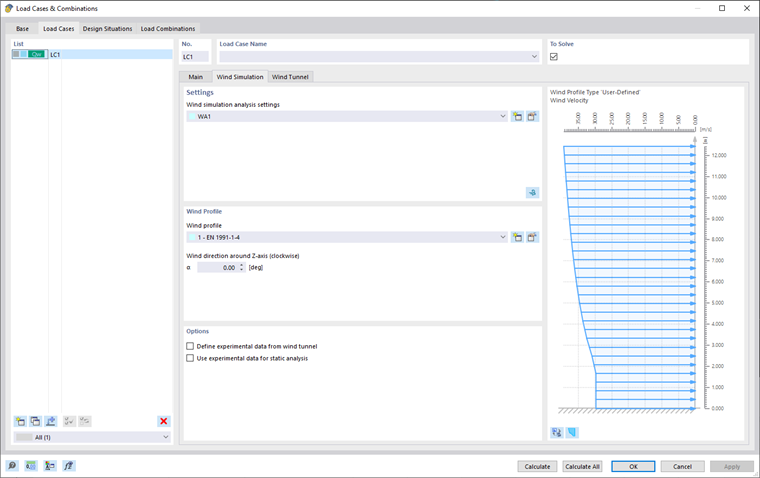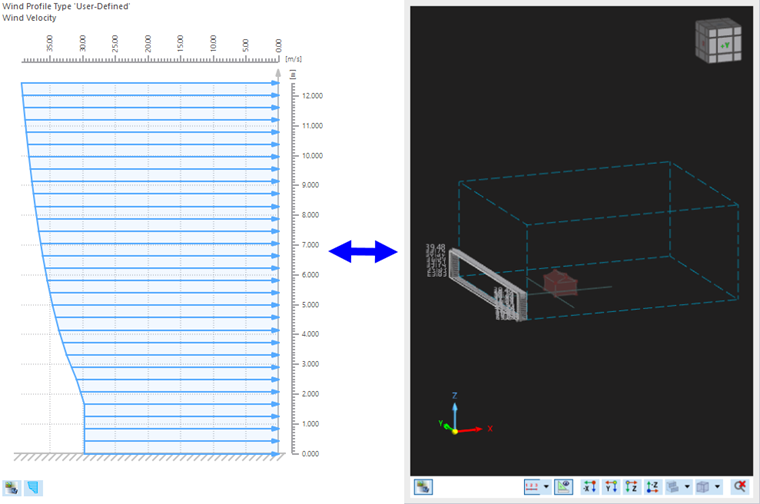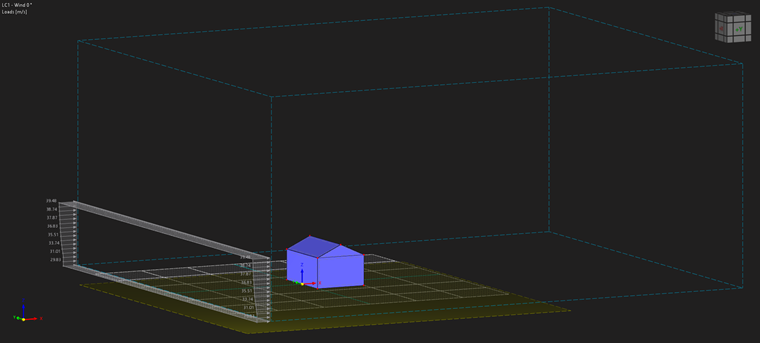列表
在“荷载工况”选项卡的左侧列出了模型中的所有荷载工况。 你可以创建、复制、删除荷载工况。 下表介绍了列表末尾的其他按钮功能。
|
|
新建荷载工况 |
|
|
复制选定的荷载工况 |
|
|
将荷载添加到新的或现有的荷载工况中 |
|
|
选择所有荷载工况 |
|
|
反转选择列表中的荷载工况 |
设置
用户可以在该区域中为所选荷载工况分配“风洞模拟分析设置”。
可以从列表中选择 "WA" 或使用风洞模拟分析设置类型
![]() 是编辑按钮。 要编辑选定的风洞模拟分析设置,请点击
是编辑按钮。 要编辑选定的风洞模拟分析设置,请点击
![]() 是编辑按钮。 有关“风洞模拟分析设置”对话框的更多介绍,请参见章节 {%|002915 风洞模拟分析设置]]。
是编辑按钮。 有关“风洞模拟分析设置”对话框的更多介绍,请参见章节 {%|002915 风洞模拟分析设置]]。
RWIND 2 中的计算
也可以启动 RWIND 2,通过点击
![]() 右上角的按钮。 该功能将与其中一个荷载工况相关的模型数据导出到RWIND 2。
右上角的按钮。 该功能将与其中一个荷载工况相关的模型数据导出到RWIND 2。
在那里您可以查看风洞、网格、模型简化等的设置。 如有必要,可以调整参数。 这里是一个常见过程的示例:
- 启动 RWIND 2 计算。
- 检查计算结果。
- 退出 RWIND 2 并返回 RFEM 6/RSTAB 9。
- 计算剩余的荷载工况。
- 在工作窗口和表格中检查导入的荷载。
- 如果需要,在荷载和结果组合中将风荷载工况与其他荷载工况组合。
- 开始计算变形和内力。
更多信息,请参阅知识库文章。
风剖面
在该区域中,可以将“风剖面”分配给所选荷载工况。 您可以通过单击
![]() 是编辑按钮。 要编辑选定的风剖面,请使用
是编辑按钮。 要编辑选定的风剖面,请使用
![]() 是编辑按钮。 关于“风剖面”对话框的介绍,请参阅风剖面。
是编辑按钮。 关于“风剖面”对话框的介绍,请参阅风剖面。
风剖面显示在窗口的右侧。 用户可以通过
![]() 是编辑按钮。 的
是编辑按钮。 的
![]() 按钮可以在风剖面和风洞模型%\}显示之间进行切换。
按钮可以在风剖面和风洞模型%\}显示之间进行切换。
【风向】影响着模型在风中的暴露程度。 风向与模型全局 X 轴正方向的夹角 α。 旋转以绕 Z 轴正方向顺时针方向定义。
“地形偏移”选项控制建筑物的哪一部分暴露在风中。 默认值为零,这意味着风围绕模型的最低点流动。 如果模型中包含地下室楼层或地基,则地形平面也要相应地进行调整。 该值是参照全局 Z 轴的方向: 如果该选项为正,模型将向下移动。 这意味着无法定义倾斜的地形。
空中建模 有关地形定义和创建偏移的更多信息,请参见章节 网格设置 。
下图显示了地形的最终偏移(水平面)。
选项
“定义风洞中的实验数据”选项允许您在定义的“附加面结果点”处设置实验风压,勾选该复选框将打开一个新的选项卡"实验数据",用于输入数据和必要的参数,见章节 {%@004172 实验数据 ]] 了解更多信息。
第二个选项“使用实验数据进行静力分析”允许使用RFEM中的静力分析对指定的实验数据进行后处理。



